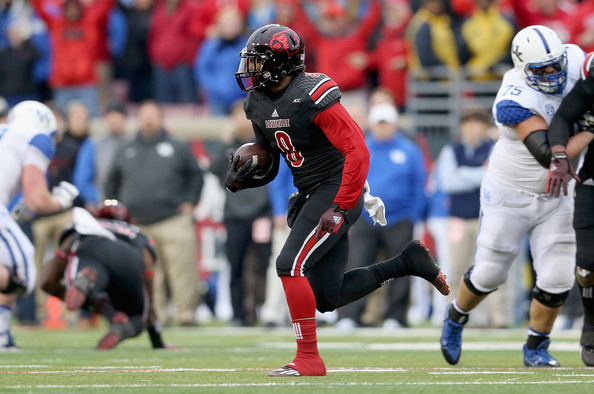On the heels of the conclusion of the 2015 NFL Draft, I began to realize the need to enhance my understanding of each team’s draft history; what they’ve built or attempted to build over the past ten years and how they’ve went about that process.
This may seem tedious to you, the reader, but I think as analysts of a great game, it can be hard to criticize or praise a team without understanding the full context of how their roster and positional depth has been constructed. For example, the New York Jets and the Buffalo Bills are often ridiculed heavily for their drafting incompetence at the quarterback position, but while often grouped together, a review of their past 16 classes suggest two vastly different front office mindsets. The Jets have spent an incredible 12 picks on quarterbacks (by far the most in the AFC), while the Bills have used just four selections on signal callers over the same time period. So two teams that have had similar results at the quarterback position since 2000, but have attempted to address those issues in vastly different ways.
Similar comparisons can be made in the AFC North, a process which we began to endeavor upon with an examination of each team’s offensive and defensive draft classes over the past ten years. Today we will look at all four team’s selections from 2006-2015 in the secondary, before moving on to the offensive side of the ball tomorrow.
Defensive Backs
Cleveland Browns: 18
Cincinnati Bengals: 17
Pittsburgh Steelers: 15
Baltimore Ravens: 14
The Browns have really went all out addressing the defensive back position over the past few drafts, and the result has been one of the more talented secondaries in the game. Joe Haden is one of the NFL’s premier cover guys (except against Antonio Brown), and draftees Justin Gilbert, Pierre Desir, Ibraheim Campbell, Charles Gaines, and Ifo Ekpre-Olomu have all come to the team in the past two draft classes. That isn’t even mentioning UDFA studs Tashaun Gipson and K’Waun Williams, who have both stepped into pivotal roles with the team over their short careers.
When it comes to the way Cleveland drafts defensive backs, they’ve actually featured a rather balanced approach, with two first rounders, two second rounders, one third, and two fourths used on the position since 2006. The team does like to fish for talent late in the draft, as they’ve utilized 11 5th-7th round selections on their secondary in the past ten years, most in the AFC North. If the team had hit on more of their front seven selections of late, their secondary might be even more heralded than it already is.
Perhaps no team in the NFL has invested in the cornerback position as heavily as Cincinnati over the past ten years, as the team has used four first round picks on the position. The results have been mixed, as Johnathan Joseph excelled before moving on to the Houston Texans, Leon Hall was steady until injuries took their brutal toll, Dre Kirkpatrick has struggled but shown flashes, and Darqueze Dennardawaits his opportunity. The consistent first round investment has allowed the team to bypass the position in the middle rounds for the most part, with just four picks in the 3rd/4th rounds and none in the second in the last ten years. The Bengals secondary has been very good over the past few seasons, also largely thanks to key free agent signings in the past.
The anti-Bengals in many ways, the Steelers have ignored defensive back needs like perhaps no team in the NFL over the past ten seasons. Until the drafting of Senquez Golson in the second round a month ago, the Steelers had spent zero first or second round picks on a defensive back since 2006. Combine that with an extensive lack of quality moves in free agency to address the position, and you have part of your answer as to why the Steelers secondary was so poor the past two seasons. The defensive backfield is simply too important an area to leave unaddressed in today’s NFL. The Steelers have learned this lesson the hard way, and hopefully the additions of Golson, Doran Grant, and Gerod Holliman in this year’s draft can assuage that decline to a degree.
The Ravens’ draft strategy is a little similar to Pittsburgh’s, but they’ve simply recognized the need to prioritize the secondary in today’s NFL quicker than the Steelers have. Of the team’s two first round picks at the position, one has become a top cornerback in the NFL (Jimmy Smith), and the other has been a total bust in two years (Matt Elam). Outside of Smith the team has really struggled to find talent in the draft in recent years, although 2009 third-rounder Lardarius Webb has shone in moments, but struggled with injuries. The team’s limited early round investment should temper expectations however, as the team has used eight of their past 14 defensive back selections on 4th-7th rounders.
You can clearly see the difference between teams that invest heavily early on at defensive back, and teams that don’t. The positions are simply that important in today’s NFL, especially cornerback. It is no wonder that teams with some of the strongest secondaries in the Seattle Seahawks, New England Patriots, and Denver Broncos have been in the Super Bowl the past two seasons. With the complex and high-octane passing offenses in the NFL today, having a premier secondary has never been at more of a premium.








